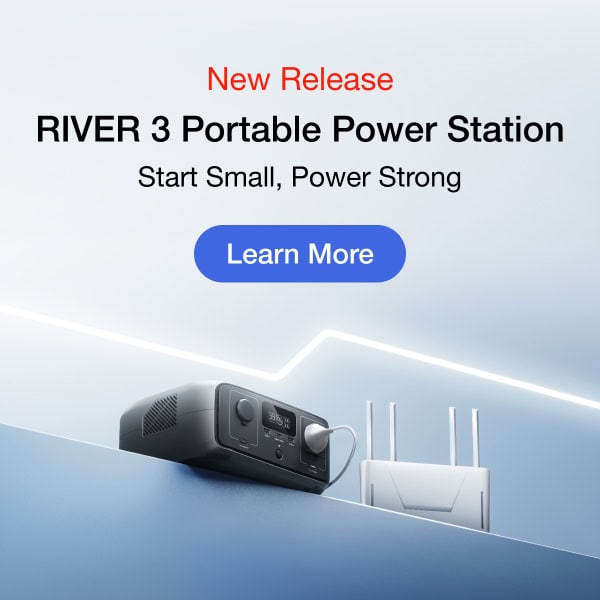Off-grid solar power systems collect the sun’s energy, convert it into electricity, and then store it in batteries so the user can draw power from it as needed. To run efficiently, you need to maximise the charge to the battery. Optimising battery performance means more than just connecting the panel to the battery; you need to control the charge going into the battery.
Different tools are available to do this. Of the options available, the most efficient device to control the charge flowing into your battery is an MPPT charge controller.
MPPT Charge Controller in the EcoFlow Power Kit
What Is an MPPT Solar Charge Controller?
When your solar panels collect solar energy, the process produces a higher output than your batteries can handle. For your system to work, you need to control the flow into the battery to get the most efficient flow and storage possible. A charge controller accomplishes this for your system.
The delivery from your panel to the battery in your system comes with voltage and amperage. Voltage measures the pressure of electrons in the system, and amperage measures the flow or current of those volts. Together, these create power, measured in watts. Getting the most power requires maximising the combination of volts and amps running through your solar system.
The MPPT solar charge controller is a DC-to-DC converter for your solar power system. It receives voltage from the solar panels and converts it to charge your battery at a more appropriate level. The optimisation helps you avoid losing some energy your system captures and generates, maximising what you can store and use.
MPPT stands for Maximum Power Point Tracking. A solar panel has different electric output and different maximum efficiency levels. The efficiency depends on numerous factors, such as the time of day, cloud cover, and temperature of the panels. The MPPT identifies the point at which your system gets maximum efficiency.
You can buy an MPPT separately if you’re building your own solar energy system. However, some products, like the EcoFlow Power Kits, come with MPPT solar charge controllers built into the system, including a DC-DC battery charger with MPPT and two additional solar charge controllers.
Check the product details of your solar generator or portable power station to see if the charge controller comes included or must be purchased separately. Be careful to ensure all the components in your system are compatible, particularly if you’re mixing and matching from different manufacturers.
How Does the MPPT Charge Controller Work?
Your solar power system operates at the highest efficiency when it matches up with the levels of your batteries. If the power input goes too high, you lose most of that energy. If it goes too low, though, you won’t get the benefit of storing enough energy to make it work. You need the right balance for your system at any time.
The right combination of amps and volts is necessary to get the maximum wattage from your solar system. Wattage is the product of amps times volts. If your battery can only hold 12 volts, the amperage must be high enough to reach the total wattage your panel should produce.
Manually figuring this out can be complicated. The panel needs to put out more than the battery voltage to balance, so the numbers are not one-to-one. The maximum power point represents the correct balance of voltage and amperage to generate the most power from your solar panel — the point at which your system loses the least solar energy while converting and transferring it through your system.
Beyond that, the optimal system amperage and voltage levels fluctuate throughout the day. The angle of the sun hitting your panels plays a role here. Cloud cover, precipitation, and temperatures also affect the levels you need, and thus the ideal combination of voltage and amperage for your system. A person can’t just run a calculation to navigate all of that.
This is where an MPPT is critical. The charge controller monitors all of these inputs digitally and constantly tracks the optimal levels. It then regulates the current from the panel and the voltage into the battery. It continually adjusts those levels to move you as close as possible to the maximum power point in each given moment for your system to operate most efficiently.
What Is the Difference Between MPPT and PWM Solar Charge Controller?
The MPPT solar charge controller is one of two primary kinds of charge controllers on the market. The alternative is a pulse width modulation or PWM charge controller. A PWM functions with a transistor that rapidly opens and closes to modulate the panels’ current.
The primary difference between the two kinds of solar charge controllers is that while the MPPT controller modulates both the voltage and the current, the PWM controller only affects the current. Since it reduces amperage without being able to affect voltage, it can’t impact the overall wattage other than to decrease from the highest output rating for your panels.
In other words, while an MPPT controller regulates optimal power output, the PWM controller only allows you to reduce the current going into the battery. Every solar panel comes with a standard rating for the wattage it can deliver. A PWM controller reduces the performance of each panel you have without the adjustments an MPPT controller can make to rebalance and make up the difference.
No solar system is 100% efficient. Depending on how the panel is set up and aligned, it usually converts only 15-20% of the sunlight it absorbs into electricity. EcoFlow’s rigid solar panels yield 23% conversion rate efficiency — amongst the best on the market. A PWM controller loses more energy as heat than an MPPT controller and fails to help you get the most from your system by only impacting half of the power equation.
Benefits of an MPPT Solar Charge Controller
The efficiency and performance of your solar generator significantly increase when you use an MPPT controller. It yields numerous benefits that help you save money and recoup your initial investment in your solar power system more quickly.
More Efficient Power Transfer
Either type of solar charge converter affects the electric current from solar panels to the battery. The current is critical since the battery can only hold so much power at a time. Sending too wide a current to the battery will mean most of the energy is lost. But because the MPPT manages the voltage and the amperage, it allows your system to store more of the rated wattage for your solar panels.
Greater efficiency is critical to getting the most from your system and meeting your electricity needs from your solar power array.
Less Dependent on Weather
A key to solar power effectively meeting your energy needs is storing energy to use when the sun isn’t shining on your solar panels.
On cloudy days, the maximum power point changes throughout the day. The more time you miss that optimal balance, the less effectively your system can operate. The MPPT controller adjusts to environmental changes and helps your system maintain the best possible output.
Fewer Panels Needed
When you get more power from each solar panel, you may need fewer panels to deliver the energy you need. On the most basic level, this lets you save money by buying a smaller solar array.
Fewer solar panels also give you more flexibility with placement. You can focus your solar panels on the parts of your roof best positioned to absorb and convert sunlight into electric power.
More Effective for Large Systems
As your system grows, getting better output from each solar panel becomes more critical. For multiple-panel solar arrays, the difference can become staggering.
Given the inevitable energy loss from the time the sunlight hits your panels to the power running through your system, improvements for each panel pay substantial dividends across your array and over time. Using an MPPT controller for large sets of panels will significantly amplify the power you can access and use.
Return on Investment
An MPPT solar charge controller costs more than a PWM controller. What you give up in up-front cost, though, you gain in functionality.
When you consider any solar energy system pays dividends through reduced energy costs and a much smaller carbon footprint that you leave behind, an MPPT solar charge controller helps you realise these benefits. It lets you receive the benefits sooner and more completely than its rival PWM controller.
Are MPPT Solar Charge Controllers Worth it?
Any time you weigh whether a major purchase is worth the cost, the answer depends on your usage, your needs, and the magnitude of the differences among options for that purchase. For an MPPT controller, it comes down to whether your benefits, including increased energy production, are enough to justify the additional cost over time.
The answer may be no if you have a minimal system — such as a River Pro solar generator for camping. Similarly, if you seldom experience rainy or cloudy weather, the fine-tuned calibration and frequent adjustments delivered by an MPPT controller may not provide a significant enough advantage to justify the additional cost. The extra power you gain may be minimal, so it could take much longer to see the cost savings you would eventually expect from using an MPPT charge controller.
Absent those circumstances, though, an MPPT solar charge controller gives you significant advantages that pay off over time. It lets you get the most out of your system, avoid lost energy, and maintain peak delivery throughout the year.
The more efficiently you generate and store energy, the more quickly your initial investment will pay off financially. An MPPT solar charge controller gets you to a positive ROI more quickly.
Conclusion
Your solar energy system represents a significant investment for your home, and an MPPT controller helps you increase your return on that investment.
Shop EcoFlow today for solar power systems that integrate MPPT controllers. Our Power Kits provide the highest quality components so your solar power system can best deliver on your needs.





